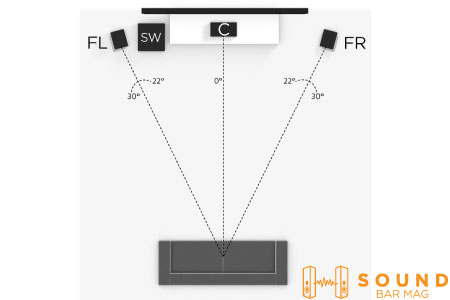When you’re talking about a surround-sound audio system, One of the factors to consider is the number of channels available. The number of speakers determines the range of streams used. By their very nature, Surround sound systems use more speakers than traditional stereo systems and thus require a higher number.
Many home theater owners want a system that blends well with their entertainment setup. It needs to match their TV, DVD player, gaming console, and more. So they set out trying to find the best 2.1 channel speaker system. But, precisely, what could the 2.1 channel imply? You shouldn’t have to be worried any longer since we have the answers!
The 2.1 channel used to be not-so-popular, but it is now a much-talked-about speaker number due to its popularity. It’s often confused with stereo and surround system channels. This article will look into what the 2.1 channel means and other associated information.
What Does 2.1 Channel Mean?
The number two and the word “one” are two words that are used to describe sound systems. It’s crucial to note that these numbers do not reflect the number of people who spoke but refer to the speaker configuration in theater, home entertainment, etc.
The number 2 stands for the number of channels wherein the speakers are arranged in a flat direction, usually at the nape of the neck, and the number 1 denotes the subwoofer, which would be located on the floor.
One left channel, one right speaker, and a subwoofer path form a 2.1 connection arrangement. A 2.1 channel setup is identical to a stereo (2.0) system; only it includes a subwoofer.
Smaller bookcase speakers for the left and proper channels and a subwoofer again for shorter wavelengths are easier to use in 2.1 channel configurations.
Soundbars are another typical 2.1 use. The left and proper channels loudspeakers are housed in the soundbar, whereas the different frequencies are usually provided (or can be added as an additional purchase) by an external subwoofer.
The 2.1 settings icon is also available on some powered sound systems (the Audi Fives and Fluance Ai60s, for instance). Maybe the left and right speakers have built-in amplification, or one speaker (typically the left speaker) houses the amplifiers, including both speakers via a connecting link in this style of setup. A subwoofer output on one of the speakers connects a powerful woofer to it (usually an optional purchase).
Vocals and dialogue are placed in both channels, even though individual sounds are allocated either left or right. The voice or song comes from the vacant center space here across left and right side loudspeakers.
Arrangement of 2.1 Channel Speakers

When shopping, all you have to do is pay attention to the number of speakers each system has. Two satellite speakers plus a subwoofer make up a 2.1 channel speaker system. There will be no center speaker needed in this setup.
The Left and Right Major speakers should be placed at a 30-degree angle along or near the extremities of the front wall, about the same distance from the sitting position. Speakers must not be positioned flush against the wall or in a corner; instead, they should be set some feet away from the fence or corner.
Furthermore, the left and right loudspeakers should be angled to directly direct music to the primary listening location (the sweet spot). Between both the two front speakers, the subwoofer must be placed on the left or right-hand side of the front wall.
You can also check our detailed guides on the 2.1 Soundbars:
Frequently Asked Questions (FAQs)
Is a 2.1 Channel Setup Appropriate for Your Audio Requirements?
One of the first things you should think about is your theatrical sound requirements. A 2.1 channel system is fantastic, but putting a little extra money into your audio devices could provide you with a better experience with dialogue-driven entertainment.
Furthermore, extreme immersion in your favorite show with surround sound is rarely linked with a 2.1 channel section, so if that’s precisely what you want, you’ll need something further sophisticated.
However, extra-crisp conversation and hearing sounds from directions aren’t always required. This is a decision that consumers must make for themselves.
Is the soundbar with 2.1 channels satisfactory?
2.1 channel soundbars are great for those with a basic sound system and want to upgrade their speakers without spending too much money. They’re also a great place to begin if you are on a budget and don’t want to get too fancy with your setup.
However, if you are looking for an upgrade, you should consider a 5.1 or 7.1 channel soundbar instead.
Is the 2.1 surround sound system suitable for watching TV?
The 2.1 sound system is perfect for apartments, dorms, small living rooms, and other spaces where space is limited, or people want to save money on buying more speakers or wiring for extra speakers.
The sound system is gaining popularity and is a more straightforward way of reproducing TV and movie sound and music with less clutter and fewer speakers.
Conclusion
2.1 channels may be more than enough, based on how you intend to utilize the speakers or soundbar. Elevated left, and right speakers paired with a dedicated subwoofer might be the ideal solution for music fans and those looking to upgrade their TV’s stereo speakers.

Mia Evelyn is a soundbar specialist and she love to test and review different soundbar brands. She shares her neutral and in-depth reviews through the Soundbar Mag.